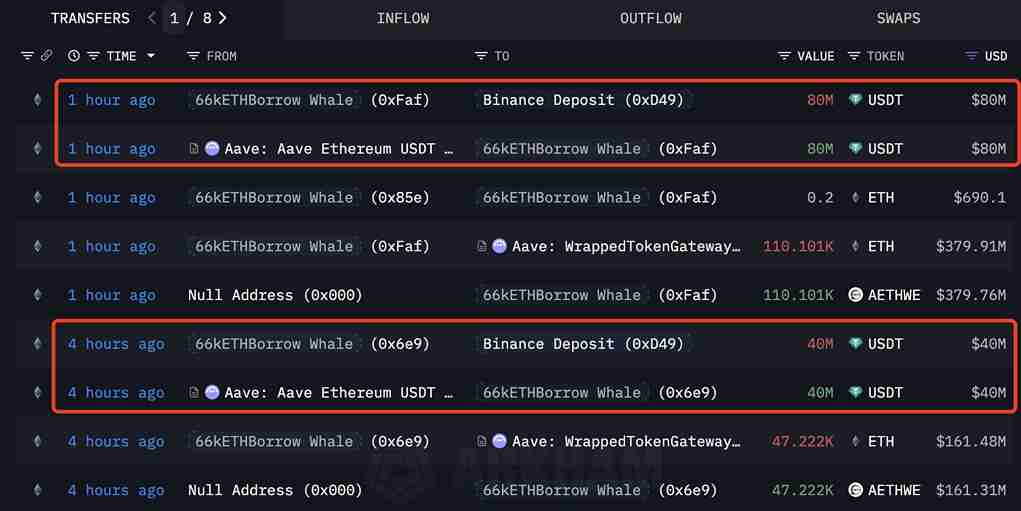Ethereum whale activity is surging as major holders borrow significant USDT from Aave to acquire more ETH, demonstrating confidence amid market uncertainty. A prominent whale, previously holding 385,718 ETH valued at $1.33 billion, recently added leverage for further buys, countering weak spot demand.
-
Ethereum whales are leveraging Aave to borrow USDT and deposit on exchanges like Binance for ETH accumulation.
-
On-chain analytics from Lookonchain reveal sustained large-scale buys despite subdued retail participation.
-
Institutional ETF outflows totaled $183.77 million recently, reducing net assets to $22.14 billion and pressuring ETH near $3,416.
Ethereum whale activity intensifies with leveraged ETH buys via Aave, signaling bullish conviction. Explore ETF outflows and price implications for informed trading decisions today.
What is driving the recent Ethereum whale activity?
Ethereum whale activity has picked up pace, with large investors using decentralized lending protocols to secure more ETH holdings. A notable whale known as “66kETHBorrow” recently borrowed 120 million USDT from Aave and transferred it to Binance, positioning for additional purchases. This move builds on prior accumulations totaling 385,718 ETH, worth approximately $1.33 billion, highlighting persistent interest from high-net-worth participants even as broader market sentiment remains cautious.
How are whales leveraging protocols like Aave in this ETH accumulation trend?
Whales are increasingly turning to lending platforms for leverage to amplify their ETH positions without liquidating other assets. Data from on-chain trackers indicates that the “66kETHBorrow” wallet executed this strategy after already amassing substantial ETH reserves. According to Lookonchain, such activities reflect a calculated bet on Ethereum’s long-term value, using borrowed stablecoins to buy during price dips. This approach minimizes immediate capital outlay while maximizing exposure, with the whale’s total borrowed ETH collateral exceeding 66,000 tokens. Market observers note that similar patterns have preceded rallies in the past, though current spot trading volumes remain low at around 20% below average levels. Expert analysis from CryptoQuant underscores that large-order clusters in spot markets are up 15% week-over-week, pointing to organized accumulation efforts. Short sentences here aid readability: Whales borrow efficiently. They deposit strategically. Accumulation persists amid volatility.

Source: X
These leveraged transactions underscore a divergence between whale behavior and retail trends. While smaller investors hesitate due to recent price consolidation breaks, whales are doubling down. On-chain metrics from Santiment show that addresses holding over 1,000 ETH have netted positive inflows of 12,500 tokens in the last week alone. This accumulation phase could stabilize ETH’s floor price around $3,300, providing a buffer against downside risks. Financial experts like those at Glassnode emphasize that such whale moves often act as leading indicators for network health, with Ethereum’s total value locked in DeFi protocols holding steady at $50 billion despite outflows elsewhere.
Frequently Asked Questions
What is the “66kETHBorrow” whale’s strategy in current Ethereum whale activity?
The “66kETHBorrow” whale employs a leverage-based accumulation approach by borrowing USDT on Aave against ETH collateral and depositing it on centralized exchanges to buy more ETH. This has resulted in holdings of 385,718 ETH, valued at $1.33 billion. The strategy signals strong belief in ETH’s upside, using borrowed funds to increase exposure without selling core assets, as tracked by on-chain data.
How might institutional ETF trends influence Ethereum’s price amid whale buys?
Recent Ethereum ETF outflows of $183.77 million have weakened institutional demand, dropping total net assets to $22.14 billion and keeping ETH prices near $3,416. While whale accumulation provides counterbalance through direct on-chain purchases, a reversal in ETF inflows would be needed for sustained rallies. This dynamic creates short-term uncertainty, but positive whale signals could attract renewed institutional interest if prices hold key supports.
Key Takeaways
- Whale Leverage on Aave: The “66kETHBorrow” entity’s recent 120 million USDT borrow enables further ETH stacking, building on $1.33 billion in prior holdings for potential long-term gains.
- ETF Outflow Pressures: Daily withdrawals of $183.77 million highlight diminishing institutional appetite, contrasting whale optimism and risking further price dips below $3,400.
- Price Outlook Dependency: ETH may target $3,700 on momentum fills, but breaking $4,300 requires ETF inflow recovery; monitor on-chain orders for directional cues.

Source: CryptoQuant
Ethereum ETF Outflows Signal Institutional Caution
Institutional participation in Ethereum has faced headwinds, with SoSoValue reporting $183.77 million in daily ETF outflows as of November 12, reducing total net assets to $22.14 billion. This pullback comes as ETH hovers near $3,416, reflecting broader caution in crypto markets. Despite whale-driven on-chain buys providing some support, the net effect of these outflows could cap upside potential unless countered by fresh capital inflows. Analysts at Farside Investors point out that such trends often correlate with 5-10% price corrections in the following weeks. Ethereum’s daily chart shows a bearish structure post-consolidation break, with support levels at $3,300 under testing. Retail sentiment, as measured by LunarCrush, remains neutral, with social mentions down 8% amid the divergence between whale aggression and institutional restraint. Key resistance at $3,500 looms, where overbought Stochastic RSI readings might trigger profit-taking.

Source: SoSoValue
The interplay between these forces—whale accumulation versus ETF reductions—defines Ethereum’s near-term trajectory. Data from Dune Analytics reveals that while spot average order sizes have spiked due to whale involvement, overall exchange inflows remain 25% below peaks from earlier in the year. This suggests selective buying rather than broad market euphoria. Ethereum’s fundamentals, including layer-2 scaling advancements and staking yields above 4%, continue to attract deep-pocketed players. However, regulatory scrutiny on ETFs, as noted in recent SEC filings, adds another layer of volatility. Traders should watch for confluence: A return of positive ETF flows could align with whale momentum to push ETH higher.
Conclusion
In summary, Ethereum whale activity through leveraged Aave borrowings contrasts sharply with ongoing ETF outflows, creating a mixed outlook for ETH prices around $3,416. Secondary factors like spot order clustering and institutional net asset reductions highlight the need for balanced analysis. As whales signal conviction in Ethereum’s ecosystem, monitoring inflow reversals will be key; investors may find opportunities in this divergence by staying attuned to on-chain developments for the next market phase.
